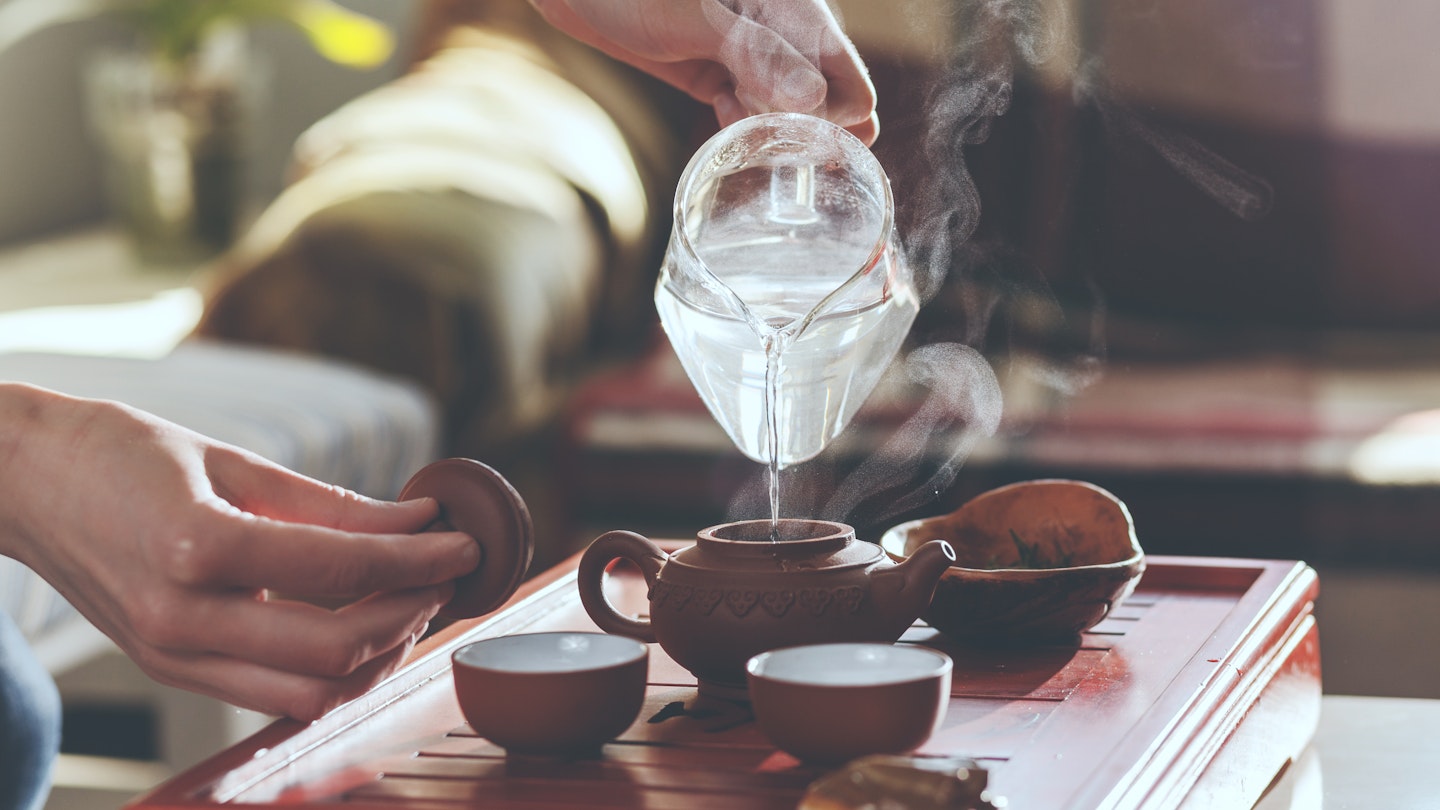Discover the World through Tea: A Global Guide
Nothing warms the soul like a good cup of tea, and many of our favorites have distinct roots in specific locations around the world. Take a global tour via tea with these herbal indulgences.
Sweet Mint Tea, Morocco

If you yearn for the historic medinas of Morocco, brew yourself and your loved ones a batch of sweet mint tea, also known as Atai Bi Nana, and dream of wandering the country’s winding streets. Traditional sweet mint tea is brewed using Chinese “gunpowder” green tea (originally from the Zhejiang Province in China), copious amounts of sugar, and fresh mint leaves.
The exact origin of this tea tradition is debated, some citing its appearance in the 19th century, arriving from England, while others say it arrived as early as the 17th century from the Middle East. Whatever the truth is, it has become an essential part of life in Morocco. The tea itself is a symbol of hospitality and welcoming, and preparation and presentation are just as important as the finished product. Hosts often pour the tea from a silver teapot into small glasses from a significant height, creating a delightful foam that indicates that the tea has been perfectly brewed. This tea is routinely served three times in a sitting, each cup offering a unique flavor experience.
Masala Chai, India

Spicy, creamy, and sometimes sweet, India’s masala chai (spiced tea) has taken the world by storm. This comforting concoction incorporates milk, sugar, black tea, and a variety of different spices depending on region and taste; the most common are cardamom, cinnamon, fennel, ginger, cloves, black pepper, and star anise. Chai wallahs (tea vendors) across India prepare perfect cups of chai to order, each with distinctive flair.
Numerous legends surround the origin of masala chai. One story traces its roots to an ancient Indian court, where a king envisioned creating a healing beverage for his people, while another attributes it to a Buddhist monk who learned from Chinese farmers. The true history, however, is linked to British colonialism and the cultivation of the tea trade in India; the tradition of masala chai gained prominence in the 1900s when Britain sought to stimulate the tea economy it controlled. Indian citizens embraced tea and crafted their own variations, adding spices that contribute warmth and depth to the beverage.
Matcha Tea, Japan

Delightfully vibrant and multifunctional, matcha tea is made from green tea leaves ground into a fine powder and whisked in water to form a frothy beverage. Like chai, matcha has garnered significant global popularity, appearing in various matcha-flavored drinks and desserts. Traditionally, however, the matcha tea ceremony serves as a Japanese cultural touchstone, utilized for both formal and informal tea gatherings, expressing hospitality and generosity towards guests.
Powdered tea saw its origins in 7th-century China when tea was dried and stored as bricks, later ground for use in beverages. Matcha was introduced to Japan in the 12th century, primarily reserved for important religious and government figures. Over the years, this practice trickled down into society, making matcha a tea enjoyed by all.
Oolong Tea, China

When it comes to tea, China is where it all began. Oolong tea is crafted from the same leaves as black and green tea, yet it undergoes only partial oxidation post-picking (black tea is fully oxidized), resulting in a unique bluish hue. The flavor of oolong can vary significantly based on the region where the leaves are grown and the oxidation techniques employed, ranging from floral and light to nutty and roasted. The most sought-after varieties originate from the Wuyi mountains in the country’s Fujian Province.
Classically, oolong teas are served during the Gongfu tea ceremony, a practice believed to have emerged during the Song dynasty and gained popularity in subsequent centuries. This ceremony demonstrates respect to both the guests and to nature, which provided the tea. Guests are invited to appreciate the aromatic qualities of the tea before sampling, and hosts prepare several infusions for everyone to enjoy.
Yerba Mate, Paraguay/Argentina/Uruguay/Brazil

If you’ve traveled to South America’s southern half, chances are you’re familiar with yerba mate, the ubiquitous infusion enjoyed from a gourd with a metal straw called a bombilla. This drink resembles green tea in flavor and is typically served using hot (but not boiling) water, meant to be sipped slowly and shared among friends and family, with the gourd passed from person to person.
Originally consumed by the Guaraní people residing in what is now Paraguay, yerba mate was recognized for its medicinal properties. The drink was soon industrialized by colonizers, even after an ill-fated ban instigated by the Spanish governor of Buenos Aires, which was largely ignored due to the strong affinity for mate. Today, it symbolizes the southern cone. While traditionalists believe yerba mate requires no modification, many variations with added sugar, citrus, and other flavors are gaining popularity.
Black Tea, United Kingdom

One can’t think of the United Kingdom without envisioning the perfect cup of black tea, swirled with milk and sugar. If you’ve poured a morning cup, consider pairing it with a biscuit or a scone. Moreover, English tea can also be enjoyed with larger spreads, such as a fancy afternoon tea at a hotel or tea shop, which might include finger sandwiches and pastries. High tea (often simply called “tea”) may sometimes be conflated with dinner, featuring more savory fare, such as meats, pickles, and tarts.
The United Kingdom’s tea heritage stretches back to the 17th century, when it was brought to the islands by the British East India Trading Company. Britain’s extensive colonial influence effectively spread tea culture worldwide, and today, tea remains a substantial part of daily life.





